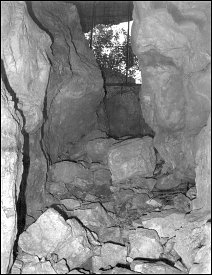

Ice cubes and ice bergs melt, but the ground? Certainly, under the right conditions. Of course, it also depends on the nature of the ground. Layers of limestone are a favorite target, because this carbonate rock reacts to acids—and plant roots produce acid.
Like most other living things, including ourselves, plants produce carbon dioxide as a waste product of living. Produced by the living tissue of roots, it reacts with ground water in the soil to form the relatively weak carbonic acid. This acid may be mild, but rocks have no timeline to meet. Percolating along joints in the limestone and given a few hundred thousand or million years, the acidic waters dissolve tunnels and rooms. And if the water table falls, emptying the caverns, mineral-laden waters dripping from above begin to reverse the process, slowly building up stalagmites and stalactites.
A number of limestone regions in our desert are dotted with cave
openings and sinkholes formed by roof collapse of chambers and passageways, forming
what geologists call a karst landscape.

Contributor: Arthur H. Harris, Laboratory for Environmental Biology, Centennial Museum, University of Texas at El Paso.
Desert Diary is a joint production of the Centennial Museum and KTEP National Public Radio at the University of Texas at El Paso.

This photograph, taken from within Dry Cave, Eddy Co., NM, looks up toward the exit which, in turn, is at the bottom of a sink. Such features have been formed by solution followed, in some cases, by collapse. The entrance has been gated by the Bureau of Land Management to help protect scientifically important data from vandals or uneducated visitors. Photograph by A.H. Harris, ca. 1970.
Jennings, J. N. 1985. Karst geomorphology. Basil Blackwell, Oxford, United Kingdom. 293 pp.
Veni, G., H. DuChene, N. C. Crawford, C. G. Groves, G. N. Huppert,
E.H. Kastning, R. Olson, and B. J. Wheeler. 2001. Living with karst. A fragile
foundation. American Geological Institute, Alexandria, VA. 65 pp. ![]()